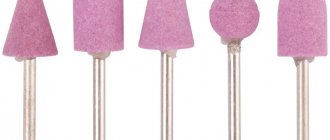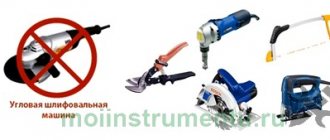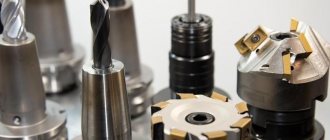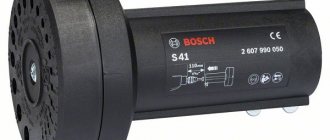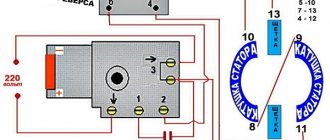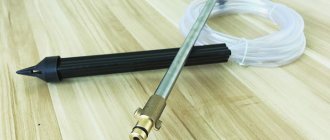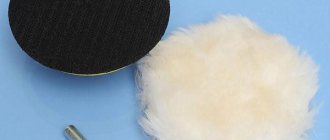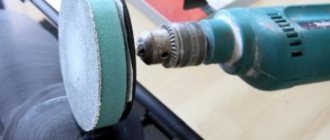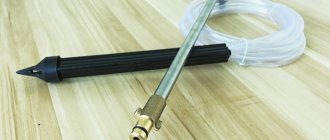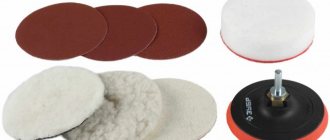Every man should have such things as a grinder and a drill in his assortment of tools. A grinder can clean metal from old paint and corrosion. In everyday life, a drill can greatly facilitate repair work if you need to stir any mixture or tighten screws.
But each of these tools has a common goal - cleaning the surface from rust and corrosion. For this, metal brushes are used. You can find photos of metal brushes on the Internet so you don’t make a mistake in choosing. In this article we will look at the types of brushes.
Brushes for drills and grinders
Tools such as drills and grinders can clean any surface from rust and corrosion. Let's look at the main types of brushes.
Advantages and disadvantages of sanding attachments
Despite the abundance of solutions, such devices are still auxiliary and are not suitable for solving specific problems. One of the main drawbacks is the weight of the drill. It is difficult to hold a heavy instrument with outstretched arms or above your head. Because of this, the quality of surface treatment and the duration of the procedure suffer.
But where high precision is not required, such as stripping materials or peeling walls, this point is not critical. In a word, a grinding attachment for a drill is a household device that does not pretend to be of a professional level.
A clear advantage of a tandem of a drill and an attachment is its low cost and accessibility. By spending a few hundred rubles, you can get a return that is more than adequate for your household needs. Whereas buying professional equipment will cost a pretty penny. And it is not a fact that the tool will be needed after the necessary work has been carried out.
Cup brush
The brush is capable of cleaning the surface from traces of concrete and corrosion. This kind of metal brush for grinders and drills is often used for processing flat steel products.
If you need to treat a wooden surface, you should use a nylon brush.
Types of materials for making nozzles
Materials for the working body vary greatly in softness, elasticity and abrasive grain size. The main ones are:
- Sandpaper. They vary greatly in hardness, graininess and water resistance.
- Soft materials. Serve for polishing and fine finishing.
- Grinding stones. For rough surface treatment and correction of defects.
Grinding stone
The variety of materials and shapes of devices allows you to choose the most suitable one for each specific operation. Thus, a drill attachment coated with diamond powder will allow you to polish surfaces made of the hardest materials, and miniature attachments are suitable for finishing jewelry.
Disc brush
If you need to clean a large area of the surface, then use a disc brush. It has high rigidity and strength, so you can use it for a long time.
The brush for stripping metal is manufactured using the latest technologies. This brush is usually called a brush brush and is used in industry.
Experience using a nozzle to clean old paint.
So, we are not talking about standard steel wire brushes or sandpaper attachments. Vladimir Parshin came up with an interesting solution. The device consists of three small chains fixed on the central one at an angle of 120 degrees to each other.
Nozzle for cleaning old paint
Thus, the paint stripper attachment is mounted in an impact drill or hammer drill on the central axis. Such an attachment should not be installed in a conventional drill, since use is accompanied by slight vibration and can simply damage the equipment.
The nozzle was successfully purchased from the manufacturer and it was time to put it into practice. I would like to note that it is mandatory to use safety glasses. Gloves will also not be superfluous. During use, fragments of old paint fly out at high speed from under the moving parts of the nozzle and although they do not pose a danger to the skin, if they get into the eyes they can cause significant harm. This is immediately warned about in the instructions. The first copy was not very successful (a total of 4 samples were purchased). In the first half hour, 2 links of the chain fell off the nozzle at each end (there are three jokes in total), that is, the length of the leashes from the chain was almost halved. This did not make me very happy, since during this time only about 0.5 m2 was removed. The links flew out rather harmlessly, despite the high speeds, they mostly flew into the wall opposite to the one being hit or into the floor. The direction in which the paint peels off should also be taken into account.
The nozzle is installed in the hammer drill
This is what the attachment on a hammer drill for removing old paint from walls looks like. As you can see, it is impossible to install it in a standard mount, so it is secured in a classic clamping chuck.
Most rotary hammers and some drills have the ability to twist in two different directions. This is quite convenient, because in this case you can work comfortably both left-handed and right-handed. Also, if the rebound and the direction of torsion is from top to bottom, then the likelihood of a dangerous tearing off of a chain link becomes less likely. The second copy turned out to be more successful and with its help it was possible to remove about 2.5 m2 of a triple layer of old paint. True, even here several links of the chain managed to fly off, this affected the quality and speed of the beating, but the work could be continued.
The second prototype of a nozzle for removing old paint
As you can see in the photo, 2 links flew off from one end, one link from the second, and the third remained intact. The end links are a little burnt. During operation, there was a slight smell of burning, which suggested that the hammer drill might have overheated, but most likely it was the attachment links that were burning. This nozzle is unlikely to withstand the same volume. Regarding the design, I would like to note that such a product can be made independently.
Corbrush
Brushes are used to clean parts from rust and flux deposits. Also, if it is necessary to give the product a marketable appearance, this type of brush is used.
In industry, a good and correct brush is used in the production of aluminum radiators for various brands of cars.
Which nozzle to choose?
The choice of drill attachment depends on the material being processed, the shape of the workpiece, and the required technological operation. The choice depends on the type of equipment:
- Pad designs are used for polishing, rough or finishing grinding of metal surfaces.
- Cup attachments are used when stripping metal of rust, protective or decorative coatings.
- Disk equipment is used when processing hard-to-reach places.
- Drum devices allow you to process the inside of holes and the ends of metal sheets.
- Soft materials are used when working with surfaces that are not resistant to mechanical stress.
- End bits are popular in jewelry making. You can choose a form to process hard-to-reach areas.
It is necessary to correctly select the spindle speed during operation. If the speed is too high, the material may be damaged.
Cup attachment for drill
Types of hardness
The work performed depends on the pile. The following wires are distinguished:
- Corrugated. This brush reduces machine vibration and applies gentle pressure to the surface. This happens due to the fact that the brush has springing properties;
- Twisted. The bristles curl and give a harsh action on the plane. The brush has great strength;
- Smooth. The brush quickly loses its shape and over time is unable to do its job.
All brushes differ in their cup diameter.
Which drill is suitable for this attachment?
The paint remover is simple and practical: it is compatible with most models of modern power tools (Russian and foreign). To make processing of old surfaces more effective, it is recommended to use drills:
- with reverse, which will help adapt to different conditions;
- designed for long-term operation, including in vibration mode;
- having a stepped or smooth speed controller.
Such a power tool will help you process walls much faster and easier, without spending much effort.
Results of using a drill attachment to clean paint.
Now I would like to talk about the results. In three hours, about 3 square meters of wall were processed, the first nozzle was used until it was unusable and the second one was worn out by half. The dust from this method of cleaning old paint is really much less than from a grinder, router, grinder or plane. It is quite difficult to remove paint near the floor, especially if you do not want to damage it, so remove the paint before you level the floor. The popular Makita HR2470 rotary hammer was used as a twisting tool, which worked perfectly. I would like to note that the nozzle does not have any fastening and must be clamped using a classic chuck, which does not exist in hammer drills, so a standard clamping chuck for the hammer drill was purchased additionally.
Wall cleaned using a chain attachment
Getting to the paint near the floor was quite difficult. the first thing that stopped me was the fact that as the rotating units approached, a huge cloud of dust rose. The second is the fear that you can damage the floor, which was recently filled using self-leveling floors.
Cleared wall
Around the sockets and in the corner, it turned out quite successfully and carefully to remove the paint without damaging anything. To remove the layer behind the pipes, it is unlikely that you will be able to use a nozzle, so you will have to use coarse sandpaper and a scraper spatula.
Surface cleaned with different tools
This photo has been specially processed a little to show how different a wall cleaned with a scraper and with a nozzle is.
As you can see, where the hammer drill with chains worked, there are small irregularities that will have a beneficial effect on the adhesion to the plaster. If you need one-time work to clean old paint from walls, then this attachment will really suit you. It may take longer than using a special router, but it is quite suitable as a budget solution to the problem of removing old paint. After treating it with a nozzle, the wall becomes rough, which is very suitable for further priming and plastering. Facebook

